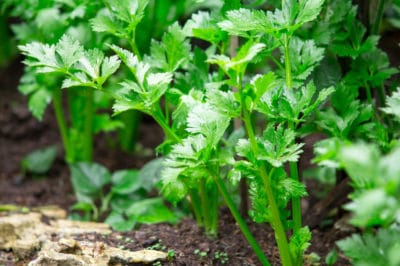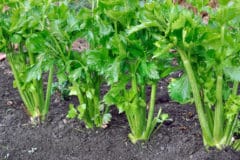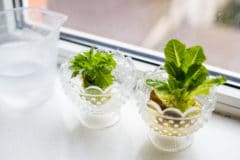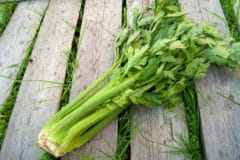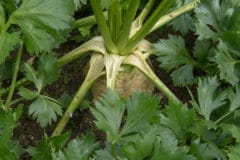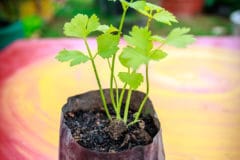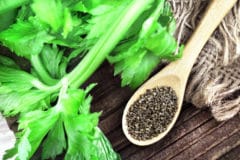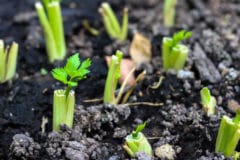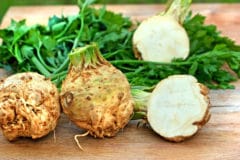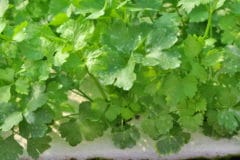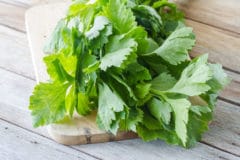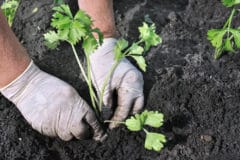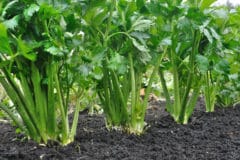What Kind of a Plant is Celery?
Celery is a long-season plant related to carrots and parsley that developed in marshy conditions of salt flats in the Mediterranean. A biennial, it sends up a tall flowering stalk in the second year. The seeds are pollinated by insects. Humans eat celery in the form of stalks, leaves and roots. The dried seeds are also used as food and – in some cultures – medicine.
Are There Different Kinds of Celery?
Celery is available in several different types. The typical garden celery has stout, thick stems and is available in green, red and yellow green. Wild celery, or smallage, is similar but has thinner stalks and a stronger flavor. Leaf celery or Chinese celery is similar to the wild form. Celeriac is a form of celery grown for its thick, fleshy root.
What Celery Varieties are Available?
Pascal celery is the most commonly grown. This is the standard celery found in the grocery. Maturity rates vary from 80 to 100-plus days. Varieities include:
- Ventura
- Tango
- Parcel
- Utah
Chinese celery may be ready in 45 to 60 days. Chinese celery varieties include:
- Kintsel
- White Queen
- White Stem
Celeriac is a long-season plant, with maturities of 90 to 130 days. Varieties include:
- Diamant
- Large Smooth Prague
- Brilliant
Where Does Celery Grow?
As a marsh plant that originated in a temperate climate, celery will grow best in similar conditions. Most gardeners can grow celery by manipulating growing conditions. Short season gardeners must start seeds indoors to get mature plants. Gardeners in hot areas do better growing celery as a fall/winter crop. In most zones, celery will do best grown as transplants for late spring or early summer harvest.
What Kind of Soil Does Celery Need?
Celery is often called a “muck plant.” It needs nutrient-rich, well-drained soil. Celery should never be shorted on water – if it is, it will quickly become stringy and bitter. Prepare the soil with liberal amounts of compost, well-aged manure or rotted leaves. Add a balanced organic fertilizer and side-dress the plants with more fertilizer once a month in the growing season.
What’s the Best Way to Germinate Celery?
Start seeds inside about 10 to 12 weeks before the last expected frost. The seeds are very small and it may be easier to mix with sand prior to sowing them. Soaking the seeds overnight promotes germination. Just barely cover the seeds with soil. Keep the soil temperatures between 70 to 75°F (21 to 24°C). Air temperature should be 60 to 70°F (16 to 21°C).
How Should I Fertilize Celery?
Soil for growing celery should have liberal amounts of compost and well-rotted leaves or aged manure added. In addition, celery benefits from regular applications of organic 5-10-10 fertilizer. Apply about one tablespoon per plant, sprinkled in a shallow furrow about three inches away and covered with soil. Water in well. Manure tea is also a good choice for fertilizing celery.
How Should I Water Celery?
Keep celery’s swamp origins in mind when applying water. Unless you have extremely heavy clay soil or literally flood the plants, you almost can’t over-water celery. Keep the soil moist at all times. Celery has shallow roots, so the top four to six inches of soil should never be allowed to dry out. A soaker hose or drip lines are ideal.
When Can I Grow Celery?
Stalk and leaf celery are cool season plants. Try to time your sowing so the celery is ready to harvest before the hot days of summer arrive. Depending on your climate, you may also be able to sow seeds in late summer for fall growth. In very warm climates, celery is best grown in the winter for spring harvest.
Can I Grow Celery in the Shade?
Celery prefers full sun for best color and flavor. However, it will tolerate some shade, especially in late spring and early summer when the weather is warming. Try to ensure that it has morning rather than hot afternoon sun. Celery should have a minimum of six hours of sunlight a day or it may become leggy.
Do I Need to Blanch Celery?
Celery that is blanched has a slightly sweeter taste and is lighter green than unbleached celery. However, unbleached celery has more nutrition. Blanching celery is really a matter of personal taste. You can also grow self-blanching celeries. To blanch, hill up soil around the plants, wrap with thick brown paper or put a cut milk carton over the stalks of the plant. Celeriac doesn’t need blanching.
Should I Grow Both Celery and Celeriac?
Although members of the same family, these vegetables look, taste and are used very differently. Celery is primarily a salad and crudite ingredient, although the stalks and leaves may also be used in soups and stews. Celeriac is a root vegetable which can be roasted or julienned for salads, such as the classic celery remoulade. Celeriac also stores very well in the garden over the winter.
Does Celery Have Any Pests?
Celery tastes good to insects as well as people. Aphids, earwigs wireworms, cabbage loopers, slugs and snails all like celery. Healthy, well-grown plants can tolerate a little chewing. You can hand-pick many of these pests or use a garlic and pepper spray as a repellant. Encourage predator insects such as lady bird beetles (lady bugs) for aphids and use ducks for earwigs and snails.
What Diseases Affect Celery?
Damping off, blights and fungus may occur – they are more likely if soil doesn’t drain well. Make sure plants are adequately spaced to promote good air circulation. Plant resistant varieties of celery when possible. Practice good garden sanitation – keep tools clean and disinfect if necessary. Remove infected plants immediately. A heaping tablespoon of baking soda in a gallon of water can be used as a fungicide.
Can Celery be Used in Companion Planting?
Some gardeners swear by companion planting to promote growth or decrease insect damage. In the case of celery, lettuce, spinach and English peas make good companion plants. They like similar soil and growing conditions. Cucurbits like pumpkins, squash and cucumbers tend to have antagonistic effects toward celery and should be planted some distance away.
How Should I Harvest Celery?
Stalk and leaf celery can be harvested by cutting off individual stalks, but it does increase the risk of insect attacks and rot. It’s better to harvest the entire head by digging it up. Cut off the roots but leave the bundle of stalks intact so the plant won’t fall apart. With celeriac, the root is harvested by digging it up.
Can I Save Celery Seeds?
Celery is pollinated by insects and different varieties of celery will cross-pollinate. It is also a biennial, so you must grown it into a second spring to get seed. Choose an open-pollinated variety and make sure that you are only growing that variety. Insects can travel several miles, so to ensure pure seed, cage your celery plants and hand-pollinate.
What’s the Best Way to Store Celery?
Stalk and leaf celery store well in the refrigerator. It will keep better if wrapped in aluminum foil. Storing it in a plastic bag makes it deteriorate more quickly. You can also store it in the garden until hard frosts hit. Celery dug carefully and replanted in boxes of damp sand can be stored in a root cellar for a couple of months. Keep the roots moist. Celeriac stores well in the garden.
How Can I Use Celery?
Stalk celery makes a natural container for various stuffing like cheese dip, cream cheese and peanut butter. Both stalks celery and the stalks of leaf celery can be eaten raw as crudites. Chopped celery adds flavor to soups, casseroles and stews. Celeriac is often grated or julienned and served as a salad. It can also be gratineed or roasted. Celery seeds are used for flavoring.
